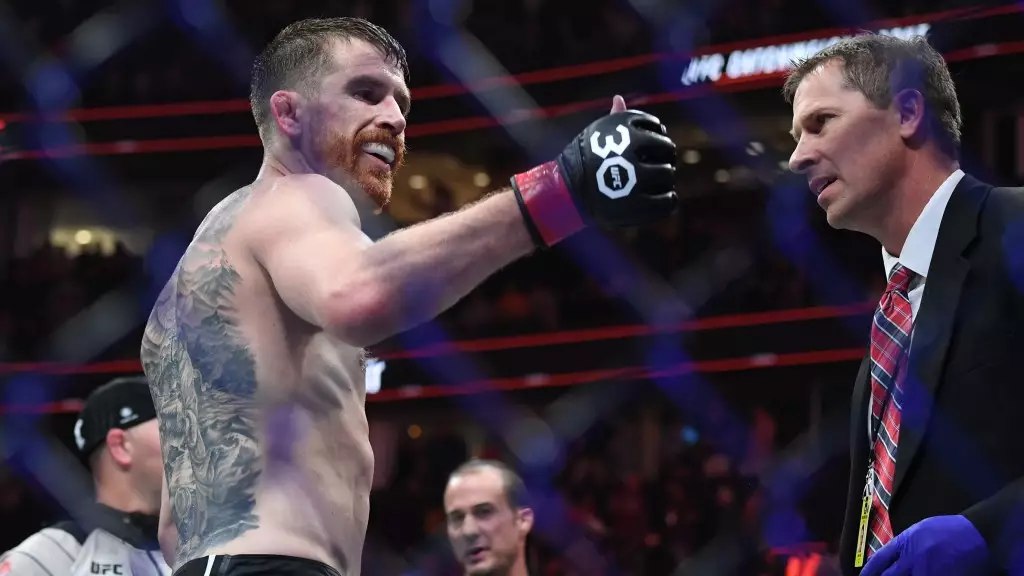Cory Sandhagen is not just another name in the volatile world of the UFC bantamweight division; he embodies the determination of a fighter laser-focused on achieving championship glory. Set against the backdrop of mixed martial arts, his upcoming battle against Deiveson Figueiredo on May 3 is not merely a match—it’s a declaration of intent. After suffering a regretful unanimous decision loss to Umar Nurmagomedov, Sandhagen stands at a crossroads, understanding that victory in this bout could catapult him directly into title contention.
With his current record of 17 wins and 5 losses, and a notable history in the octagon with 10 victories against 4 defeats in the UFC, Sandhagen finds himself both pressured and motivated. For him, this fight in Des Moines, Iowa, is more than an opportunity—it’s a pivotal moment to remind everyone of his combat prowess and survival instincts in a sport that waits for no one.
The Strategic Mindset
What makes Sandhagen particularly compelling is not just his skill set but the strategic mindset he brings into the cage. Despite his recent setback, Sandhagen retains a sense of optimism, believing he remains only one or two fights away from the coveted title shot. The bantamweight landscape is complex, particularly with current champion Merab Dvalishvili poised for a rematch against Sean O’Malley, leaving the division rife with potential yet competitive pathways.
Sandhagen’s unique perspective is shaped by the fact that he hasn’t faced either of these top-tier fighters. In an ecosystem where anticipation often yields greater fan engagement, Sandhagen’s ability to market his potential matchups positions him as a fan favorite. The narrative of being the “last man standing” who deserves a chance at the championship is a powerful one, and he recognizes that a dynamic win against Figueiredo could serve as an emphatic statement.
Skills and Strengths Against Figueiredo
When analyzing matchups such as these, it’s critical to identify the fighter’s strengths and how they match up against the opponent’s weaknesses. Sandhagen notes that he feels particularly confident facing Figueiredo, citing how well he performs against aggressive opponents seeking to finish fights, whether through submissions or knockouts. This understanding of his own combat style and adaptability reflects a fighter who is in tune with himself and his competition.
Moreover, Sandhagen’s aspirations this year are not limited to mere participation in the sport. He has expressed a desire for an ambitious schedule—aiming for three fights in 2025, including what he hopes will culminate in a title shot. This ambition is daring, bordering on audacious; it signifies a fighter who is not only ready to face his fears but is also willing to risk it all to achieve greatness.
Fan Chemistry and Marketability
Sandhagen’s awareness of the fanbase dynamics is crucial for any fighter looking to ascend within the UFC’s ranks. He understands that there is a palpable desire from fans to see him clash with O’Malley. This demand becomes a cornerstone for his marketing strategy. Engaging in such promotional mind-games not only builds intrigue but also amplifies Sandhagen’s visibility within the sport’s ecosystem.
Whether the outcome is favorable or not against Figueiredo, Sandhagen values the role fan reaction plays in his career. By tapping into this resource of public sentiment, he effectively turns his bouts into more than mere competitions—they become events where emotions run high, and stakes are visibly felt. This unique engagement can serve to transform the narrative around his career and solidify his presence in the hierarchy of the division.
In a sport that often favors flash over substance, Sandhagen distinguishes himself by finding a balance—his strategic approach, compelling communication with fans, and a heart dedicated to the sport make him a challenger to watch closely. His journey through the pressures of the bantamweight division ultimately reflects the relentless pursuit of excellence that defines true champions.

